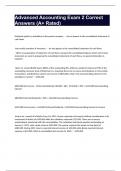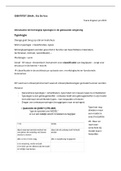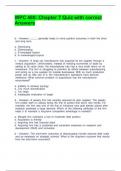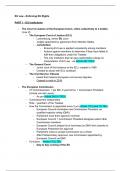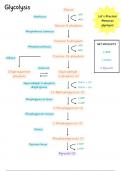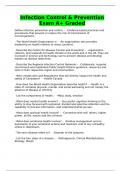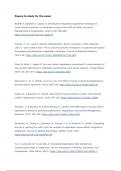Answers (A+ Rated)
Dividends paid by a subsidiary to the parent company - - do not appear in the consolidated statement of
cash flows
Intra-entity transfers of inventory - - do not appear in the consolidated statement of cash flows
- effect on preparation of statement of cash flows: because the consolidated balance sheet and income
statement are used in preparing the consolidated statement of cash flows, no special elimination is
required
Akers Co. owned 8,000 shares (80%) of the outstanding 8%, $100 par, preferred stock and 70% of the
outstanding common stock of Brickman Co. Assuming there are no excess amortizations or intra-entity
transactions, and Brickman reports net income of $810,000, what is the noncontrolling interest in the
subsidiary's income? - $235,000
$810,000 Net Income − Preferred Dividends (10,000 × $8) = $730,000 × 30% = $219,000 Noncontrolling
Interest
$80,000 Preferred Dividends × 20% = $16,000 Noncontrolling Interest
$219,000 from Income + $16,000 Preferred Dividends = $235,000 Noncontrolling Interest in Income
Kearns Inc. owned all of Burke Corp. For 2021, Kearns reported net income (without consideration of its
investment in Burke) of $350,000 while the subsidiary reported $127,000. There are no excess
amortizations associated with this consolidation. The subsidiary had bonds payable outstanding on
January 1, 2021, with a book value of $303,000. The parent acquired the bonds on that date for
$285,000. During 2021, Kearns reported interest income of $32,000 while Burke reported interest
expense of $29,000. What is consolidated net income for 2021? - $492,000
,Income of the Parent $350,000 + Income of the Subsidiary $127,000 − Difference in Interest Income over
Interest Expense on Intra-Entity Bonds ($32,000 − $29,000) $3,000 + Gain on Bonds Purchase ($303,000
− $285,000) $18,000 = $492,000 Consolidated Net Income
Duncan Inc. owned all of the outstanding stock of Brandt Co. The subsidiary had bonds payable
outstanding on January 1, 2020, with a book value of $270,000. The parent acquired the bonds on that
date for $291,000. Subsequently, Duncan reported interest income of $26,000 in 2020 while Brandt
reported interest expense of $31,000. Consolidated financial statements were prepared for 2021. What
adjustment would be required for the retained earnings balance as of January 1, 2021? - Reduction of
$16,000
Bond Acquisition Price $291,000 − Bonds carrying amount $270,000 = $21,000 R/E Reduction.
Intra-Entity Interest $31,000 − $26,000 = $5,000 R/E Increase
$21,000 R/E Reduction − $5,000 R/E Increase = $16,000 R/E Reduction
Jacoby Co. owned a controlling interest in Trimble Inc. Jacoby reported sales of $510,000 during 2021
while Trimble reported $300,000. Inventory costing $27,000 was transferred from Trimble to Jacoby
(upstream) during the year for $54,000. Of this amount, 30% was still in ending inventory at year's end.
Total receivables on the consolidated balance sheet were $115,000 at the first of the year and $158,000
at year-end. No intra-entity debt existed at the beginning or ending of the year. Using the direct
approach, what is the consolidated amount of cash collected by the business from its customers? -
$713,000
Parent's Sales $510,000 + Subsidiary's Sales $300,000 − Intra-Entity Sales $54,000 − increase in A/R
$43,000 ($158,000 − $115,000) = $713,000 Consolidated Cash Collected
Popper Co. acquired 80% of the common stock of Cocker Co. on January 1, 2019, when Cocker had the
following stockholders' equity accounts.
Common stock — 40,000 shares outstanding $140,000
Additional paid-in capital $105,000
Retained earnings $476,000
,Total stockholders' equity $721,000
To acquire this interest in Cocker, Popper paid a total of $682,000 with any excess acquisition date fair
value over book value being allocated to goodwill, which has been measured for impairment annually
and has not been determined to be impaired as of January 1, 2022.
Popper did not pay any premium when it acquired its original interest in Cocker. On January 1, 2022,
Cocker reported a net book value of $1,113,000 before the following transactions were conducted.
Popper uses the equity method to account for its investment in Cocker, thereby reflecting the change in
book value of Cocker.
On January 1, 2022, Cocker issued 10,000 additional shares of common stock for $21 per share. Popper
did not acquire any of this newly issued stock. How would this transaction affect the additional paid-in
capital of the parent company? - Decrease it by $64,720
Consideration transferred $682,000
Noncontrolling interest acquisition-date fair value $170,500
Increase in Sub book value ($1,113,000 − $721,000) $392,000
Stock issue proceeds $210,000
Subsidiary valuation basis $1,454,500
New parent ownership (32,000 shares ÷ 50,000 shares) 64%
Parent's post-stock issue ownership balance $930,880 Parent's investment account ($682,000 + [80% ×
392,000]) $995,600
Required adjustment — decrease $(64,720)
Popper Co. acquired 80% of the common stock of Cocker Co. on January 1, 2019, when Cocker had the
following stockholders' equity accounts.
Common stock — 40,000 shares outstanding $140,000
Additional paid-in capital $105,000
Retained earnings $476,000
Total stockholders' equity $721,000
, To acquire this interest in Cocker, Popper paid a total of $682,000 with any excess acquisition date fair
value over book value being allocated to goodwill, which has been measured for impairment annually
and has not been determined to be impaired as of January 1, 2022.
Popper did not pay any premium when it acquired its original interest in Cocker. On January 1, 2022,
Cocker reported a net book value of $1,113,000 before the following transactions were conducted.
Popper uses the equity method to account for its investment in Cocker, thereby reflecting the change in
book value of Cocker.
On January 1, 2022, Cocker reacquired 8,000 of the outstanding shares of its own common stock for $34
per share. None of these shares belonged to Popper. How would this transaction have affected the
additional paid-in capital of the parent company? - Decrease it by $23,100
Adjusted acquisition-date fair value ($852,500 + $392,000) $1,244,500
Less Stock repurchase $(272,000)
Adjusted fair value after stock repurchase $972,500
New parent ownership (32,000 shares ÷ 32,000 shares) 100%
Fair value equivalency of parent's ownership $972,500
Parent's investment account ($682,000 + [80% × $392,000]) $995,600
Required adjustment—decrease$(23,100)
New bonds are issued from a parent to its subsidiary - - Any premium or discount on bonds payable is
exactly offset by a premium or discount on bond investment
- There will be $0 net gain or loss on the bond transaction
- Interest expense needs to be eliminated on the consolidated income statement
- Interest revenue needs to be eliminated on the consolidated income statement
- FALSE: A net gain or loss on the bond transaction will be reported
The accounting problems encountered in consolidated intra-entity debt transactions when the debt is
acquired by an affiliate from an outside party include all of the following except: - A gain or loss must be
recognized by both parent and subsidiary companies

